Values
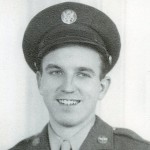
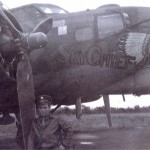 After World War II, many of the veterans were hesitant to talk about their experiences. My dad, Allen Spencer was one of those men. We were never exactly sure why he didn’t talk about it, but thought that he didn’t want to brag. I don’t really think that was it at all.
After World War II, many of the veterans were hesitant to talk about their experiences. My dad, Allen Spencer was one of those men. We were never exactly sure why he didn’t talk about it, but thought that he didn’t want to brag. I don’t really think that was it at all.
While listening to an audiobook called Citizen Soldiers, which covers the D-Day battle and the Battle of the Bulge, it hit me…even before the author said it. The reason soldiers didn’t talk much about war was a deliberate effort to forget. Unfortunately for most of her them, forgetting was impossible. Their minds were filled with haunted memories. The book mostly covers the thoughts of the infantry, but touches on the air war too.
After listening to the author’s account of the battle, I don’t think I could ever forget either, and I wasn’t there. Memories of the 19 year old farm boy away from home for the first time, and not really trained for combat. When the shooting started, he stood up to fire. Other soldiers told him to get down, by it was too late. His first battle had become his last, as an enemy bullet pierced his forehead. The soldiers who witnessed it, felt sick to 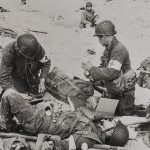
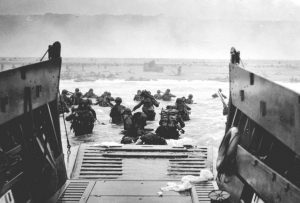 their stomachs. It was a time when a seasoned veteran was just 22 years old…and he had been made an office when his commanding officer was killed. There weren’t very many of the older men left…and by older I mean 30.
their stomachs. It was a time when a seasoned veteran was just 22 years old…and he had been made an office when his commanding officer was killed. There weren’t very many of the older men left…and by older I mean 30.
There were memories of a young prisoner of war, packed into a train to the POW camps was singing in his beautiful tenor voice, all the Christmas music he could think of to help raise moral. It was working, but suddenly the trains were under attack. The prisoners couldn’t get out, and the guards had run away. Finally a skinny boy was able to get out through a tiny window. He opened the door to his car and the men moved to free the other prisoners. There was really nowhere to go, but they escaped the attack. Then, the guards came back and loaded them back on the train. When someone asked the tenor to sing some more, they were told that he hadn’t made it back. His sweet voice was forever silenced. The men on the train were silent too…sick at heart.
The fighters in the plane’s overhead knew that it was kill or be killed, but whenever a plane went down, enemy 
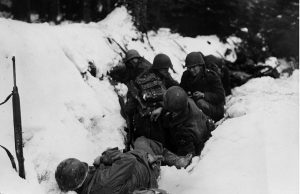 or one of theirs, they counted the parachutes, hoping the men got out alive. For them non the planes dropping bombs, they knew that someone below went to work that day, having no idea tat they would not be returning home again. They had been simple factory workers, just doing what they were told. And what of the missed targets that landed bombs on schools and other civilian locations. The men in the planes above had to live with that. They had done their duty, but it certainly didn’t feel good.
or one of theirs, they counted the parachutes, hoping the men got out alive. For them non the planes dropping bombs, they knew that someone below went to work that day, having no idea tat they would not be returning home again. They had been simple factory workers, just doing what they were told. And what of the missed targets that landed bombs on schools and other civilian locations. The men in the planes above had to live with that. They had done their duty, but it certainly didn’t feel good.
 I have long been interested in war, and especially World War II. Every aspect of it interests me, and I find myself wondering about the enemy. I’m sure that might seem odd to many people, but as we have found in the United States, just because the government goes to war, does not mean that every citizen, or even every soldier agrees with the reasons the country has gone to war. I have been listening to a couple of audiobooks that have taken in D-Day, and I came across something interesting.
I have long been interested in war, and especially World War II. Every aspect of it interests me, and I find myself wondering about the enemy. I’m sure that might seem odd to many people, but as we have found in the United States, just because the government goes to war, does not mean that every citizen, or even every soldier agrees with the reasons the country has gone to war. I have been listening to a couple of audiobooks that have taken in D-Day, and I came across something interesting.
Without going into all of that amazing strategy of warfare, I want to focus on one of the bombing maneuvers that took place. One of the soldiers on the ground was trying to take cover from incoming German bombs. After the bombing stopped, he looked out and was shocked to see eight bombs embedded in the ground near his foxhole. They had not gone off. He knew that it is possible for bombs to be duds, but he hadn’t heard of any American bombs that had turned out to be duds…especially eight of them at the same time, in the same place.  He wasn’t bragging on the American bombs, their craftmanship, or their ingenuity, but rather, wondering how so many German bombs could have been duds…all at the same time.
He wasn’t bragging on the American bombs, their craftmanship, or their ingenuity, but rather, wondering how so many German bombs could have been duds…all at the same time.
Then the soldier made an observation that I had not considered, but that fell right into my view that not everyone in Germany agreed with Hitler. The American bomb builders were doing their job willingly. They were working to make the bombs efficient, because Germany needed to be defeated. In contrast, the German bomb builders were actually Polish slaves. Hitler had invaded their nation and was forcing them to play a part in a war that they disagreed with. The soldier considered these things and came to the conclusion that somehow the Polish slaves had been able to build a bomb that they knew would not explode, but would still pass the inspections of the Germans. The soldier believed that eight unexploded bombs could not be coincidental. It had to be sabotage.

In my research, I have seen situations where the citizens have helped the enemy, at great risk to their own safety. I have seen situations where the citizens have given aid to the enemy. And this situation was a blatant sabotage of the weapons of warfare. Within their nations, these acts were acts of treason, but they were actually fighting the evil that had tried to take over their nation. Within their confines, they were standing up for their values…for good, and for what was right. They were the enemy, in location only, because in their hearts, the were fighting for what was right, and I have to respect them for that.
 Emma Gatewood was a survivor. When I read the first few lines about her, I thought her story was remarkable, but as I read the whole story, I realized just how remarkable she really was. Emma’s married life was pure torture, with the exception of her children, whom she dearly loved. Emma married her husband, Perry Clayton Gatewood, a 26 year old school teacher, turned farmer, when she was just 19 years old. He was a horrible man, who immediately put her to work building fences, burning tobacco beds, and mixing cement, in addition to her household chores. Three months after their wedding, he started to beat her, a practice he continued until, one day in 1939, he broke her teeth, cracked one of her ribs and bloodied her face. Women didn’t have as many options back then, so Emma was stuck. Because Emma threw a sack of flour at him, the police came and arrested her, not him, and put her in jail. The next day, when the mayor saw her battered face, he took her to his own home, where she remained under his protection until she got back on her feet.
Emma Gatewood was a survivor. When I read the first few lines about her, I thought her story was remarkable, but as I read the whole story, I realized just how remarkable she really was. Emma’s married life was pure torture, with the exception of her children, whom she dearly loved. Emma married her husband, Perry Clayton Gatewood, a 26 year old school teacher, turned farmer, when she was just 19 years old. He was a horrible man, who immediately put her to work building fences, burning tobacco beds, and mixing cement, in addition to her household chores. Three months after their wedding, he started to beat her, a practice he continued until, one day in 1939, he broke her teeth, cracked one of her ribs and bloodied her face. Women didn’t have as many options back then, so Emma was stuck. Because Emma threw a sack of flour at him, the police came and arrested her, not him, and put her in jail. The next day, when the mayor saw her battered face, he took her to his own home, where she remained under his protection until she got back on her feet.
Emma and Perry had 11 children, and unfortunately, the treatment of their mother was not hidden from them. Nevertheless, the story of Emma’s abuse at the hands of her husband went untold for more than a 50 years. In 2014, a newspaper reporter named Ben Montgomery, Emma’s great grand nephew, told her story in his book, “Grandma Gatewood’s Walk.” Emma Rowena (Caldwell) Gatewood passed away on June 04, 1973 in Gallipolis, Ohio, of an apparent heart attack, at the grand old age of 85, having accomplished much since her birth on  October 25, 1887, in Gallia County, Ohio. Her father, Hugh Caldwell, a farmer, had lost a leg after being wounded in the Civil War and in his depression, turned to a life of drinking and gambling. Her mother, Evelyn (Trowbridge) Caldwell, raised the couple’s 15 children, who slept four to a bed in the family’s log cabin.
October 25, 1887, in Gallia County, Ohio. Her father, Hugh Caldwell, a farmer, had lost a leg after being wounded in the Civil War and in his depression, turned to a life of drinking and gambling. Her mother, Evelyn (Trowbridge) Caldwell, raised the couple’s 15 children, who slept four to a bed in the family’s log cabin.
In an interview with her children, Montgomery, who worked for The Tampa Bay Times in Florida. In his research for the book, her surviving children spoke with him and entrusted him with her journals, letters, and scrapbooks. In that material he found stark references to what she had withheld from news interviewers: that her husband had nearly pummeled her to death several times. During one beating, she wrote, he broke a broom over her head. Her children told Montgomery that their father’s sexual hunger had been insatiable and that he forced himself on their mother several times a day. He made their lives a nightmare for years.
The woods became a place of solace and safety for Emma, who would often escape to them amid her husband’s rants. She came to view the wilderness as protective and restorative. In 1937 she left him and moved in with relatives in California. She was forced to leave behind two daughters, ages 9 and 11, who were still at home. Emma knew her husband would not beat the girls, and she could not afford to take them with her. She wrote to the girls to explain it to them, making sure not to leave a return address. In the letter, she wrote, “I have suffered enough at his hands to last me for the next hundred years.” Nevertheless, Emma couldn’t stand to be away from her girls any longer, so she returned after a few months. Her life became a prison after that. Her husband would not let her out of his sight. She later wrote that in 1938, he beat her “beyond recognition” 10 times. “For a lot of people the trail is a refuge,” Brian B. King, a publisher of guidebooks and maps for the Appalachian Trail Conservancy, said in a telephone interview. “But seldom is it a refuge for something as bad 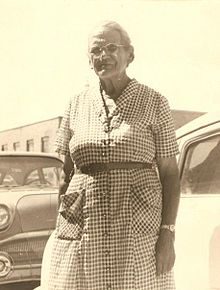 as that.” A short time later, her husband left for good, filed for divorce, which was granted in 1941, and he was out of her life.
as that.” A short time later, her husband left for good, filed for divorce, which was granted in 1941, and he was out of her life.
Emma’s hiking became a saving grace for her…she loved it. In 1949, she came across a National Geographic magazine article about the Appalachian Trail and became intrigued to learn in reading it that no woman had ever hiked it solo. In 1954, in her first attempt at hiking the Appalachian Trail, she started out in Maine, but broke her glasses, got lost, and was rescued by rangers, who told her to go home. Undaunted, she tried again in 1955, starting from Georgia this time. She was 67 years old, a mother of 11, a grandmother and even a great-grandmother when she became the first woman to hike the entire Appalachian Trail by herself in one season. She would go on to repeat the feat 2 more times. Soon everyone was calling her “America’s most celebrated pedestrian.” In 1959, Emma went on to conquer the 2,000 miles of the Oregon Trail, trekking alone from Independence, Missouri to Portland, Oregon.
 Whenever I come across a book about World War II, and especially about a B-17 Bomber, I want to read it. That subject holds my interest mostly because my dad, Allen Spencer was a top turret gunner and flight engineer on a B-17 bomber stationed at Great Ashfield, Suffolk, England. Lately, I have been “reading” by way of Audible.com, and I must say that having a book read to you, allows you to sit back and enjoy it as if you were watching it unfold before your very eyes. So, when I came across a book called The Lost Airman written by Seth Meyerowitz, I knew I had to hear about it. As the true story began, I found that Arthur Meyerowitz (Seth Meyerowitz’ grandfather) could have been my own dad…at least to the extent that both of them were in the Eight Air Force stationed in England. Arthur was assigned to a B-24 Liberator. At first their experiences were probably almost identical. Arriving at his base, Arthur heard the men who had been there a while, tease the newcomers with things like “You’ll be sorry you came here” or “Look, fresh meat.” I can only imagine how that kind of thing must have felt to the new and often very young airmen…like a swift kick in the gut!! Then the book went on to tell how the airmen felt on their first mission, when no one could eat breakfast, because of the churning in their stomach. Arthur was the flight engineer and top turret gunner, just like my dad had been. It was the job of the flight engineer to check the plane over to ensure that it was fight worthy, and report to the captain. Arthur found problems with their plane, Harmful Lil Armful, and told his captain it needed repairs, but his captain wouldn’t hear of it. He was close to going home, and wanted his last mission out of the way, and besides what did this “newbie” know. He was only on his second mission, and he was filling in for someone else. So, they took off…a catastrophic decision.
Whenever I come across a book about World War II, and especially about a B-17 Bomber, I want to read it. That subject holds my interest mostly because my dad, Allen Spencer was a top turret gunner and flight engineer on a B-17 bomber stationed at Great Ashfield, Suffolk, England. Lately, I have been “reading” by way of Audible.com, and I must say that having a book read to you, allows you to sit back and enjoy it as if you were watching it unfold before your very eyes. So, when I came across a book called The Lost Airman written by Seth Meyerowitz, I knew I had to hear about it. As the true story began, I found that Arthur Meyerowitz (Seth Meyerowitz’ grandfather) could have been my own dad…at least to the extent that both of them were in the Eight Air Force stationed in England. Arthur was assigned to a B-24 Liberator. At first their experiences were probably almost identical. Arriving at his base, Arthur heard the men who had been there a while, tease the newcomers with things like “You’ll be sorry you came here” or “Look, fresh meat.” I can only imagine how that kind of thing must have felt to the new and often very young airmen…like a swift kick in the gut!! Then the book went on to tell how the airmen felt on their first mission, when no one could eat breakfast, because of the churning in their stomach. Arthur was the flight engineer and top turret gunner, just like my dad had been. It was the job of the flight engineer to check the plane over to ensure that it was fight worthy, and report to the captain. Arthur found problems with their plane, Harmful Lil Armful, and told his captain it needed repairs, but his captain wouldn’t hear of it. He was close to going home, and wanted his last mission out of the way, and besides what did this “newbie” know. He was only on his second mission, and he was filling in for someone else. So, they took off…a catastrophic decision.
This was where and similarities between Arthur’s experiences, and those of my dad ended, because my dad was not shot down like Arthur’s plane was. At the point Arthur’s plane was going down, his pilot and co-pilot showed incredible cowardice, and abandoned the plane first…something that was just not done. Arthur tried to  make sure everyone was off, but in the end, one man was stuck and injured. He told Arthur to go and take the newcomer with him, but the newcomer wouldn’t go. He fought Arthur, and actually kicked him off the plane, physically. As Arthur fell, he was sickened by the fact that his pilot and co-pilot jumped first, and that his friends would not be coming home. The pilot and co-pilot spent the rest of the war in a prison camp, but the outcome for Arthur was different, and in fact, miraculous, in more ways than one, because Arthur was not only an airman in the US Army Air Forces, but he was also a Jewish man facing the Nazis in World War II…a perilous place to be.
make sure everyone was off, but in the end, one man was stuck and injured. He told Arthur to go and take the newcomer with him, but the newcomer wouldn’t go. He fought Arthur, and actually kicked him off the plane, physically. As Arthur fell, he was sickened by the fact that his pilot and co-pilot jumped first, and that his friends would not be coming home. The pilot and co-pilot spent the rest of the war in a prison camp, but the outcome for Arthur was different, and in fact, miraculous, in more ways than one, because Arthur was not only an airman in the US Army Air Forces, but he was also a Jewish man facing the Nazis in World War II…a perilous place to be.
It was at this point in the book that my interest in it changed, because this could have been the fate of my dad, had his plane been shot down, but it hadn’t. While the outcome for Arthur was better than that of his crew mates, he still went through a harrowing experience, as did those who helped him. Arthur came down in occupied France on December 31, 1943, and in his landing, he badly hurt his back. From that point on, Arthur came in contact with some of the most amazing people on earth in that or any other time. The French resistance network took Arthur in, and over the next six months, they slowly smuggled him and a British Airman out through Spain to the Rock of Gibraltar. These people did this with precision and secrecy. They knew that if they were caught, they would be killed, but they hated the Nazis, and would do anything to fight against the Nazi regime…right up to, and for some, including giving their lives. The chances they took and the hardships they faced…voluntarily, were so far above and beyond the call of duty, that it almost seemed like a fictional movie. You know, the kind where the good guys always win, and the bad guys always lose. Nevertheless, this wasn’t a fictional movie, and the lives lost were real, but Arthur  Meyerowitz was not among the lives lost. His was saved because of the selfless acts of so many people in the French Resistance. The story of Arthur Meyerowitz was, for me, so moving that in the end, I cried, and throughout the book, there were moments that I could hardly breathe with the tension of the situations they found themselves in. I felt bad to think it, but I was so thankful that my dad’s B-17 always made it home, and he never had to face the prison camps, or try to escape from a hostile nation. For Arthur, his escape was miraculous, and I believe it was because of the fervent prayers of his family and the undying faith of his mother, who believed that God would bring her son home…and God did.
Meyerowitz was not among the lives lost. His was saved because of the selfless acts of so many people in the French Resistance. The story of Arthur Meyerowitz was, for me, so moving that in the end, I cried, and throughout the book, there were moments that I could hardly breathe with the tension of the situations they found themselves in. I felt bad to think it, but I was so thankful that my dad’s B-17 always made it home, and he never had to face the prison camps, or try to escape from a hostile nation. For Arthur, his escape was miraculous, and I believe it was because of the fervent prayers of his family and the undying faith of his mother, who believed that God would bring her son home…and God did.
 Twenty years ago today, two teenaged gunmen walked into Columbine High School and opened fire, killing 13 people. Yesterday, I watched a news broadcast about the aftermath of those killings. One of the parents, commented on the fact that since Columbine, every time a school shooting occurs, it is compared to Columbine…often stated, “It was a Columbine-like shooting.” Those words had become synonymous with Columbine High School. Like a dark cloud, the stigma of that shooting comes back every time there is another shooting. Twenty years later, the parents and families of the 13 victims of Columbine want to change that…to remove the dark cloud, because if we continue to call shootings Columbine-like…it’s like they win. The grief and pain continue. They do not want their loved ones to always be associated with sadness and defeat. I think that is an amazing idea.
Twenty years ago today, two teenaged gunmen walked into Columbine High School and opened fire, killing 13 people. Yesterday, I watched a news broadcast about the aftermath of those killings. One of the parents, commented on the fact that since Columbine, every time a school shooting occurs, it is compared to Columbine…often stated, “It was a Columbine-like shooting.” Those words had become synonymous with Columbine High School. Like a dark cloud, the stigma of that shooting comes back every time there is another shooting. Twenty years later, the parents and families of the 13 victims of Columbine want to change that…to remove the dark cloud, because if we continue to call shootings Columbine-like…it’s like they win. The grief and pain continue. They do not want their loved ones to always be associated with sadness and defeat. I think that is an amazing idea.
One of the victims, Lauren Townsend loved animals. She volunteered at the local animal shelter, so her parents 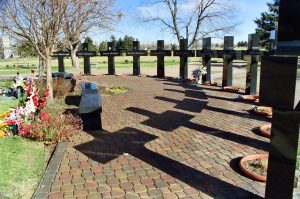 decided to remember her by setting up the Lauren Townsend Memorial Wildlife Fund. Cassie Bernall’s family started the Cassie Bernall Foundation. Their latest project is The Books for Classrooms program. Steven Curnow was a member of the Cornish American Heritage Society from an early age, and in fact he was their youngest member, so his family set up the Steven Curnow Memorial Foundation in support of the Cornish American Heritage Society. Several of the victims had planned to join the military after high school. They were made honorary veterans. Coach William “Dave” Sanders is credited with saving untold numbers of students as he ran into the cafeteria and told them to flee the building. Then he left to warn other students, sacrificing his own life for others. The softball field at Columbine has been named after him, and a scholarship program was set up in his honor. Each of the people who died that day was filled with promise. They were Rachel Scott, Daniel Rohrbough, Coach Dave Sanders, Kyle
decided to remember her by setting up the Lauren Townsend Memorial Wildlife Fund. Cassie Bernall’s family started the Cassie Bernall Foundation. Their latest project is The Books for Classrooms program. Steven Curnow was a member of the Cornish American Heritage Society from an early age, and in fact he was their youngest member, so his family set up the Steven Curnow Memorial Foundation in support of the Cornish American Heritage Society. Several of the victims had planned to join the military after high school. They were made honorary veterans. Coach William “Dave” Sanders is credited with saving untold numbers of students as he ran into the cafeteria and told them to flee the building. Then he left to warn other students, sacrificing his own life for others. The softball field at Columbine has been named after him, and a scholarship program was set up in his honor. Each of the people who died that day was filled with promise. They were Rachel Scott, Daniel Rohrbough, Coach Dave Sanders, Kyle  Velasquez, Steven Curnow, Cassie Bernall, Isaiah Shoels, Matthew Kechter, Lauren Townsend, John Tomlin, Kelly Fleming, Daniel Mauser, and Corey DePooter. Their families would like them to be remembered for their accomplishments and their dreams, rather than as victims. They would like the school to be remembered as a place of renewal, healing, and mostly of peace. They noted that Columbine means little doves… among other things. I rather prefer the Victorian meaning, which is resolved to win. I think that if the names of the killers are forever forgotten and never mentioned again; and if these lost ones are remembered for their winning spirit, their loving ways, and their kindness to others, then the right side wins.
Velasquez, Steven Curnow, Cassie Bernall, Isaiah Shoels, Matthew Kechter, Lauren Townsend, John Tomlin, Kelly Fleming, Daniel Mauser, and Corey DePooter. Their families would like them to be remembered for their accomplishments and their dreams, rather than as victims. They would like the school to be remembered as a place of renewal, healing, and mostly of peace. They noted that Columbine means little doves… among other things. I rather prefer the Victorian meaning, which is resolved to win. I think that if the names of the killers are forever forgotten and never mentioned again; and if these lost ones are remembered for their winning spirit, their loving ways, and their kindness to others, then the right side wins.
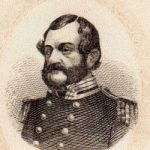 Captain George Hollins joined the United States Navy when he was just 15 years old, and served during the War of 1812. His was a long and distinguished career, but when the Civil War broke out in 1861, he chose to resign his commission, and offer his services to the Confederacy. After a brief stop in his hometown, Baltimore, Hollins offered his services to the Confederacy and received a commission on June 21, 1861. I suppose that every man had to choose a side in the Civil War, and I’m sure he considered his reasons for choosing the Confederacy to be valid, but many of us would consider his actions to be almost traitorous, were it not for the fact that both sides were the United States…just not so united.
Captain George Hollins joined the United States Navy when he was just 15 years old, and served during the War of 1812. His was a long and distinguished career, but when the Civil War broke out in 1861, he chose to resign his commission, and offer his services to the Confederacy. After a brief stop in his hometown, Baltimore, Hollins offered his services to the Confederacy and received a commission on June 21, 1861. I suppose that every man had to choose a side in the Civil War, and I’m sure he considered his reasons for choosing the Confederacy to be valid, but many of us would consider his actions to be almost traitorous, were it not for the fact that both sides were the United States…just not so united.
Hollins devised a plan to capture a commercial vessel that was bringing supplies to the Union Army. Then they planned to use that ship to lure other Union ships into Confederate service. Soon after, Hollins met up with Richard Thomas Zarvona, a fellow Marylander and former student at West Point. Zarvona  was an adventurer who had fought with pirates in China and revolutionaries in Italy. He seemed the perfect co-conspirator for this project. They devised a plan to capture the Saint Nicholas. Then it would be the decoy they used to force other Yankee ships into Confederate service. Zarvona went to Baltimore,where he recruited a band of pirates, who boarded the Saint Nicholas as paying passengers on June 28, 1862. Using the name Madame La Force, Zarvona disguised himself as a flirtatious French woman. Hollins boarded the Saint Nicholas at its first stop.
was an adventurer who had fought with pirates in China and revolutionaries in Italy. He seemed the perfect co-conspirator for this project. They devised a plan to capture the Saint Nicholas. Then it would be the decoy they used to force other Yankee ships into Confederate service. Zarvona went to Baltimore,where he recruited a band of pirates, who boarded the Saint Nicholas as paying passengers on June 28, 1862. Using the name Madame La Force, Zarvona disguised himself as a flirtatious French woman. Hollins boarded the Saint Nicholas at its first stop.
A while later the band of co-conspirators went to the “French woman’s” cabin. Inside, they armed themselves and came back out on the deck to surprise the crew. After 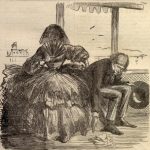 capturing the crew, Hollins took control of the ship. At this point, the purpose of their mission began. They had planned to capture a Union gunboat, the Pawnee, but it was called away. Instead, the Saint Nicholas and its pirate crew came upon a ship loaded with Brazilian coffee, and two more ships, carrying loads of ice and coal. Both ships quickly fell to the Saint Nicholas. For his actions, Hollins received a promotion to commodore and was sent to New Orleans to command the naval forces there at the end of July. On July 8, he would try another daring mission, to capture the Columbia, a sister ship of the Saint Nicholas, but the captain of the Saint Nicholas was on board the Columbia, on his way home after being released by the Confederate authorities. He recognized the men and they were arrested. It was the end of his tirade.
capturing the crew, Hollins took control of the ship. At this point, the purpose of their mission began. They had planned to capture a Union gunboat, the Pawnee, but it was called away. Instead, the Saint Nicholas and its pirate crew came upon a ship loaded with Brazilian coffee, and two more ships, carrying loads of ice and coal. Both ships quickly fell to the Saint Nicholas. For his actions, Hollins received a promotion to commodore and was sent to New Orleans to command the naval forces there at the end of July. On July 8, he would try another daring mission, to capture the Columbia, a sister ship of the Saint Nicholas, but the captain of the Saint Nicholas was on board the Columbia, on his way home after being released by the Confederate authorities. He recognized the men and they were arrested. It was the end of his tirade.
 When we think of the Old West, the Pioneer movement, the Gold Rush, and generally, the settling of the United States, our minds immediately go to the brave men who fought the Indians, ran the wagon trains, weathered the harsh winters looking for their fortunes, and fought in the wars to make this a free nation, but seldom do we think of the anonymous heroes of that time…the women. There is a saying, “Behind every great man there’s a great woman.” that saying is one reference to the many women who have set aside their own comforts to support their man in the goals and dreams he has. In many ways that saying is the picture of the Pioneer woman, but it actually leaves something out. Just because her man did not become famous, doesn’t mean that the woman was any less behind him, supporting him in all he did.
When we think of the Old West, the Pioneer movement, the Gold Rush, and generally, the settling of the United States, our minds immediately go to the brave men who fought the Indians, ran the wagon trains, weathered the harsh winters looking for their fortunes, and fought in the wars to make this a free nation, but seldom do we think of the anonymous heroes of that time…the women. There is a saying, “Behind every great man there’s a great woman.” that saying is one reference to the many women who have set aside their own comforts to support their man in the goals and dreams he has. In many ways that saying is the picture of the Pioneer woman, but it actually leaves something out. Just because her man did not become famous, doesn’t mean that the woman was any less behind him, supporting him in all he did.
Pioneer women were there, on the home front, working hard all day trying to keep their house clean in a rugged windswept frontier. Her floors were often made of dirt, and yet she swept them. The water came from a well, or a nearby creek, and she had to haul it into the house, because her man was off hunting to bring in food for the family. The house was crudely constructed with logs and often had a sod roof, and she was right there working like a man beside her husband to get that house built. She watched over the children, and kept them safe from the many perils that were a daily encounter. From snakes, to bears, to mountain lions, to Indians, she did what she needed to, even to the point of handling a gun as well as her husband did. And yet, history looked at her as the weaker part of the partnership, the one who needed to be sheltered and protected. History looked at her as if she could not 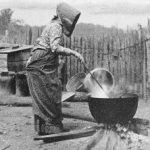 even bear to hear about certain things, because they might be too upsetting to her. In reality, they had vastly underestimated their women.
even bear to hear about certain things, because they might be too upsetting to her. In reality, they had vastly underestimated their women.
When the men got hurt, and the garden needed to be cared for, the women would till the ground…fighting with the tiller behind a horse, and winning the battle. These women took care of the house, the children, the sick or injured husband, and the garden or other crops, all without batting an eye. These women knew all about the hardships of frontier living, and when the going got tough, they didn’t turn and run back east. When the Indians attacked, they stayed and fought with their men. They could not afford to hide in a cellar, their hands were needed to hold a gun. They even faced the Indians alone, when their men were away, becoming excellent negotiators, who were able to make a trade of their wares that, in the end saved their own lives and the lives of their families. They were determined to make this new frontier work, and for the most part, they did it all without making a name for themselves. Sometimes, when we look up ancestors in historic archives, these women are either listed only as Mrs, acknowledging only the husband’s name, or they were listed only as the wife of their husband. Their true identity sometimes remains forever a mystery, and yet, they were heroes…but, they were anonymous heroes. The great men they stood behind, thereby making these men successful, may have been heroes of the frontier, and their name may have been one that every history book told us all about, 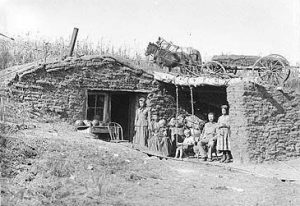 but their wives, who worked quietly beside them, remained unknown. We knew about the exploits of the men, the towns they founded, the travels they made exploring ever westward, but the women who were there with them, cooking the meals while the men talked, cleaning up afterward alone, delivering their babies often with only the help of their husband, carrying a baby, while weeding a garden, and feeding their family before themselves, going hungry, if necessary, to make sure the family was taken care of…these women rarely made the history books. Their job must have seemed to mundane to be considered adventurous, but without their contribution, this nation would not have become the great Republic that it is.
but their wives, who worked quietly beside them, remained unknown. We knew about the exploits of the men, the towns they founded, the travels they made exploring ever westward, but the women who were there with them, cooking the meals while the men talked, cleaning up afterward alone, delivering their babies often with only the help of their husband, carrying a baby, while weeding a garden, and feeding their family before themselves, going hungry, if necessary, to make sure the family was taken care of…these women rarely made the history books. Their job must have seemed to mundane to be considered adventurous, but without their contribution, this nation would not have become the great Republic that it is.
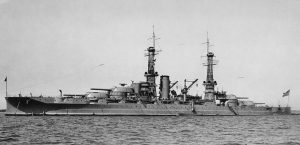 Most people know that the USS Arizona was one of the ships that was bombed when the Japanese attacked Pearl Harbor on December 7, 1941. The USS Arizona’s sinking took with it, 1,177 men…almost half of the total of 2,403 people killed at Pearl Harbor. The Arizona was one of 20 American ships and more than 300 airplanes lost that day. We know that the attack woke the sleeping giant that is the United States, and we joined World War II with the Allies to stop the tyranny that was Japan and later Germany and Italy. Most people know that the Allies were successful in World War II, and after four long years and the loss of over 400,000 lives, the war was over. There are a few facts about the USS Arizona that many people might not know, however.
Most people know that the USS Arizona was one of the ships that was bombed when the Japanese attacked Pearl Harbor on December 7, 1941. The USS Arizona’s sinking took with it, 1,177 men…almost half of the total of 2,403 people killed at Pearl Harbor. The Arizona was one of 20 American ships and more than 300 airplanes lost that day. We know that the attack woke the sleeping giant that is the United States, and we joined World War II with the Allies to stop the tyranny that was Japan and later Germany and Italy. Most people know that the Allies were successful in World War II, and after four long years and the loss of over 400,000 lives, the war was over. There are a few facts about the USS Arizona that many people might not know, however.
Twenty three sets of brothers died aboard USS Arizona. In all there were 37 confirmed pairs or trios of brothers assigned to the ship. Of the 77 men in those sets, 62 were killed. Only one full set of brothers survived. Kenneth and Russell Warriner survived because Kenneth was away at flight school in San Diego, and Russell, while badly wounded, lived. Also on board were father and son, Thomas Free and his son William who served and were killed aboard the Arizona that day. While no regulation exists, US officials discouraged siblings serving on the same ship after the Pearl Harbor attack. In addition to these men who died, the USS Arizona’s entire band, all 21 members, known as US Navy Band Unit (NBU) 22, were lost in the attack. Most of its members were up on deck preparing to play music for the daily flag raising ceremony when the attack began. They instantly moved to man their battle positions beneath the ship’s gun turret. It was the only time in American history that an entire military band died in action. In the years following the attack, and following the decision to leave the dead in the USS Arizona, it was decided that a memorial should be placed there. That is a known fact, but what I didn’t know was that in March 1961, Elvis Presley, who had recently finished a two year stint in the US Army, performed a benefit concert at 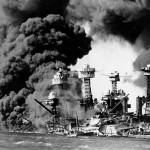
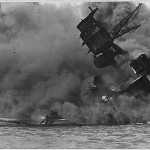 Pearl Harbor’s Block Arena that raised over $50,000. That was more than 10 percent of the USS Arizona Memorial’s final cost. The monument was officially dedicated on May 30, 1962.
Pearl Harbor’s Block Arena that raised over $50,000. That was more than 10 percent of the USS Arizona Memorial’s final cost. The monument was officially dedicated on May 30, 1962.
One of the most surprising facts about the Arizona, however, is related to the fuel. The day before the Pearl Harbor attack, the Arizona had taken on a full load of fuel…nearly 1.5 million gallons, because it was set to make a trip to the mainland later that month. When the Japanese bombers attacked, that fuel played a major part in the explosions and raging fire that followed the bombing. After the fires were put out, there were 500,000 gallons of fuel left in the ship. Now, 75 years later, the Arizona continues to spill up to 9 quarts of oil into the harbor each day. In the mid-1990s, concerns for the environment led the National Park Service to commission a series of site studies to determine the long term effects of the oil leakage. Some scientists have warned of a possible “catastrophic” eruption of oil from the wreckage, which they believe would cause extensive damage to the Hawaiian shoreline and disrupt US naval functions in the area. They continue to monitor the deterioration of the wreck site but are reluctant to perform extensive repairs or modifications due to the Arizona’s role as a “war grave.” In fact, the oil that often coats the surface of the water surrounding the ship has added an emotional gravity for many who visit the memorial and is sometimes referred to as the “tears of the Arizona” or “black tears.”
As surprising as that is, there is still one more fact that many people didn’t know. The bonds between the crewmembers of Arizona have lasted far beyond the loss of the ship on December 7, 1941. Since 1982, the US Navy has allowed survivors of USS Arizona to be interred in the ship’s wreckage upon their deaths. After a full military funeral at the Arizona memorial, the cremated remains are placed in an urn and then deposited by divers beneath one of the Arizona’s gun turrets. More than 30 Arizona crewmen who survived Pearl Harbor  have chosen the ship as their final resting place. Crewmembers who served on the ship prior to the attack may have their ashes scattered above the wreck site, and those who served on other vessels stationed at Pearl Harbor on December 7, 1941, may have their ashes scattered above their former ships. As of November 2011, only 18 of the 355 crewmen who survived the bombing of USS Arizona are known to be alive. I knew that the Pearl Harbor attack had a deep impact on the lives of the survivors, but I guess I didn’t fully understand that it was a life changing event, and it would never really leave them.
have chosen the ship as their final resting place. Crewmembers who served on the ship prior to the attack may have their ashes scattered above the wreck site, and those who served on other vessels stationed at Pearl Harbor on December 7, 1941, may have their ashes scattered above their former ships. As of November 2011, only 18 of the 355 crewmen who survived the bombing of USS Arizona are known to be alive. I knew that the Pearl Harbor attack had a deep impact on the lives of the survivors, but I guess I didn’t fully understand that it was a life changing event, and it would never really leave them.
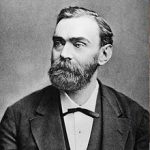 When Alfred Bernhard Nobel, the Swedish inventor of dynamite and other high explosives, died on December 10, 1896, he left a request in his will, that the bulk of his vast fortune be placed in a fund to finance an award to be “annually distributed in the form of prizes to those who, during the preceding year, shall have conferred the greatest benefit on mankind.” He did not state why he wanted to make such a bequest, but it was believed that he did so out of moral regret over the increasingly lethal uses of his inventions in war. The first Nobel Prizes are awarded in Stockholm, Sweden, in the fields of physics, chemistry, medicine, literature, and peace. The ceremony came on the fifth anniversary of Nobel’s death.
When Alfred Bernhard Nobel, the Swedish inventor of dynamite and other high explosives, died on December 10, 1896, he left a request in his will, that the bulk of his vast fortune be placed in a fund to finance an award to be “annually distributed in the form of prizes to those who, during the preceding year, shall have conferred the greatest benefit on mankind.” He did not state why he wanted to make such a bequest, but it was believed that he did so out of moral regret over the increasingly lethal uses of his inventions in war. The first Nobel Prizes are awarded in Stockholm, Sweden, in the fields of physics, chemistry, medicine, literature, and peace. The ceremony came on the fifth anniversary of Nobel’s death.
Educated in private schools in Saint Petersburg, Russia, Nobel excelled in Swedish, Russian, French, English and German. His primary interests were in English literature and poetry as well as in chemistry and physics. His interest in literature and poetry, was upsetting to his father, who considered him an introvert. He wanted his sons to become engineers, and to join his enterprise. In an effort to redirect Alfred’s interests, his father sent him abroad for further training in chemical engineering. During a two year period Alfred Nobel visited Sweden, Germany, France and the United States. In Paris, the city he came to like best, he worked in the private laboratory of Professor T J Pelouze, a famous chemist. There he met the young Italian chemist Ascanio Sobrero who, three years earlier, had invented nitroglycerine, a highly explosive liquid. Alfred Nobel proved himself to be a brilliant chemist. When his father’s business faltered after the end of the Crimean War, Nobel returned to Sweden and set up a laboratory to experiment with explosives. In 1863, he invented a way to control the detonation of nitroglycerin, which was previously regarded as too dangerous for use. Two years later, Nobel invented the blasting cap, an improved detonator that brought about the modern use of high explosives. Previously, the most dependable explosive was black powder, a form of gunpowder. Nitroglycerin remained dangerous, however, and in 1864 Nobel’s nitroglycerin factory blew up, killing his younger brother and several other people. Searching for a safer explosive, Nobel discovered in 1867 that the combination of nitroglycerin and a porous substance called Kieselguhr produced a highly explosive mixture that was much safer to handle and use. Nobel called his invention “dynamite,” for the Greek word dynamis, meaning “power.” Securing patents on dynamite, Nobel acquired a fortune as humanity put his invention to use in construction and warfare. Over his lifetime Alfred Nobel earned 355 patents.
All his work, left little time for a social life. At 43 years of age, feeling lonely and old, he placed an add for a woman who might become a suitable mate for him. The only one who came close to being the one, was Countess Bertha Kinsky, unfortunately she returned home and married Count Arthur von Suttner, but she and Nobel remained friends and kept writing letters to each other for decades. Over the years Bertha von Suttner became increasingly critical of the arms race. She wrote a famous book, Lay Down Your Arms and became a prominent figure in the peace movement. No doubt this influenced Alfred Nobel when he wrote his final will which was to include a Prize for persons or organizations who promoted peace. Several years after the death of Alfred Nobel, the Norwegian Parliament decided to award the 1905 Nobel Peace Prize to Bertha von Suttner.
The first Nobel Prizes were awarded on December 10, 1901, and subsequent prizes are awarded each year on 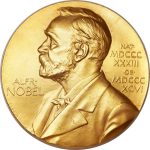 December 10, because it is the anniversary of Alfred Nobel’s death. It is the perfect day for the awards to be given. The Royal Swedish Academy of Sciences decides the prizes in physics, chemistry, and economic science. The Swedish Royal Caroline Medico-Surgical Institute determines the physiology or medicine award. The Swedish Academy chooses literature, and a committee elected by the Norwegian parliament awards the peace prize. In 2006, each Nobel Prize carried a cash prize of nearly $1,400,000 and recipients also received a gold medal, as is the tradition. Some notable winners have included Marie Curie, Theodore Roosevelt, Albert Einstein, George Bernard Shaw, Winston Churchill, Ernest Hemingway, Martin Luther King Jr, the Dalai Lama, Mikhail Gorbachev, and Nelson Mandela. All made Nobel efforts in their field.
December 10, because it is the anniversary of Alfred Nobel’s death. It is the perfect day for the awards to be given. The Royal Swedish Academy of Sciences decides the prizes in physics, chemistry, and economic science. The Swedish Royal Caroline Medico-Surgical Institute determines the physiology or medicine award. The Swedish Academy chooses literature, and a committee elected by the Norwegian parliament awards the peace prize. In 2006, each Nobel Prize carried a cash prize of nearly $1,400,000 and recipients also received a gold medal, as is the tradition. Some notable winners have included Marie Curie, Theodore Roosevelt, Albert Einstein, George Bernard Shaw, Winston Churchill, Ernest Hemingway, Martin Luther King Jr, the Dalai Lama, Mikhail Gorbachev, and Nelson Mandela. All made Nobel efforts in their field.
 Sometimes, there are events in history that end up tied to other events in history, in one way or another. On this day, December 9, 2003, Tehran, Iran was hit by unseasonably cold temperature, that led to the deaths of 40 people from hypothermia. It is very rare to see such large groups of people die in this way at the same time, but it does happen, as seen in Tehran. Their deaths occurred when their core body temperature fell to 77 degrees Fahrenheit. So, how does this have anything to do with history beyond 2003? Well, it actually does, and not in a good way.
Sometimes, there are events in history that end up tied to other events in history, in one way or another. On this day, December 9, 2003, Tehran, Iran was hit by unseasonably cold temperature, that led to the deaths of 40 people from hypothermia. It is very rare to see such large groups of people die in this way at the same time, but it does happen, as seen in Tehran. Their deaths occurred when their core body temperature fell to 77 degrees Fahrenheit. So, how does this have anything to do with history beyond 2003? Well, it actually does, and not in a good way.
Most of us, these days, know about hypothermia. In fact, the causes and the fixes are pretty well known, but what I didn’t know before, although maybe I should have, is that the information we have on hypothermia came from the horrible experiments that the Nazis performed on the prisoners at the Dachau concentration camp during World War II. These unethical medical experiments that were carried out during the Third Reich fell into three categories. The first category consists of experiments aimed at facilitating the survival of Axis military personnel. In Dachau, physicians from the German air force and from the German Experimental Institution for Aviation conducted high-altitude experiments, using a low-pressure chamber, to determine the maximum altitude from which crews of damaged aircraft could parachute to safety. Scientists there carried out so-called freezing experiments using prisoners to find an effective treatment for hypothermia. While the findings might have been a good thing, the way the experiments were carried out was horrendous. After these experiments, most people knew that if they were  outside in frigid temperatures, they could die of hypothermia. Nevertheless, there were a few miracle situations, such as the two year old girl in Canada in 1994, who survived after her core body temperature dropped to 57 degrees Fahrenheit when she wandered away from her home in Saskatchewan.
outside in frigid temperatures, they could die of hypothermia. Nevertheless, there were a few miracle situations, such as the two year old girl in Canada in 1994, who survived after her core body temperature dropped to 57 degrees Fahrenheit when she wandered away from her home in Saskatchewan.
The second category of experimentation involved developing and testing pharmaceuticals and treatment methods for injuries and illnesses which German military and occupation personnel encountered in the field. Apparently the Nazis felt free to find ways to save their soldiers lives, at the expense of their prisoners. At the German concentration camps of Sachsenhausen, Dachau, Natzweiler, Buchenwald, and Neuengamme, prisoners were subjected to immunization compounds for the prevention and treatment of contagious diseases, including malaria, typhus, tuberculosis, typhoid fever, yellow fever, and infectious hepatitis. The Ravensbrueck camp was the site of bone-grafting experiments and experiments to test the efficacy of newly developed sulfanilamide drugs. At Natzweiler and Sachsenhausen, scientists tested prisoners with phosgene and mustard gas in order to find possible antidotes. Their lives simply didn’t matter when it came to the experimentation.
The third category of medical experimentation sought to advance the racial and ideological principles of the Nazi worldview. The most infamous were the experiments of Josef Mengele at Auschwitz. Mengele conducted medical experiments on twins. He also directed serological experiments on Roma Gypsies, as did Werner  Fischer at Sachsenhausen, in order to determine how different “races” withstood various contagious diseases. The research of August Hirt at Strasbourg University also intended to establish “Jewish racial inferiority.” Other gruesome experiments meant to further Nazi racial goals were a series of sterilization experiments, undertaken primarily at Auschwitz and Ravensbrueck. There, scientists tested a number of methods in their effort to develop an efficient and inexpensive procedure for the mass sterilization of Jews, Roma Gypsies, and other groups that the Nazi leaders considered to be racially or genetically undesirable. It is difficult for me to even think about the cruelty that the Nazis inflicted on the Jews and Gypsies during those horrible years.
Fischer at Sachsenhausen, in order to determine how different “races” withstood various contagious diseases. The research of August Hirt at Strasbourg University also intended to establish “Jewish racial inferiority.” Other gruesome experiments meant to further Nazi racial goals were a series of sterilization experiments, undertaken primarily at Auschwitz and Ravensbrueck. There, scientists tested a number of methods in their effort to develop an efficient and inexpensive procedure for the mass sterilization of Jews, Roma Gypsies, and other groups that the Nazi leaders considered to be racially or genetically undesirable. It is difficult for me to even think about the cruelty that the Nazis inflicted on the Jews and Gypsies during those horrible years.

